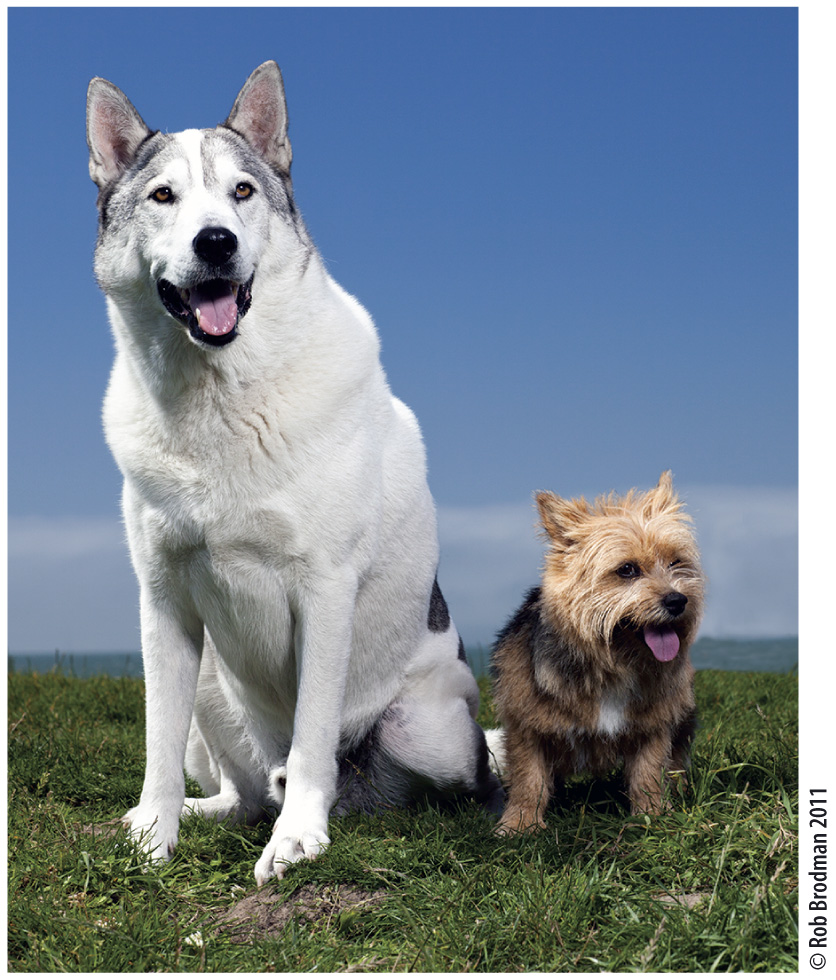Variation in populations provides the raw material for evolution.

Described in detail, evolution by natural selection calls on complex mathematical formulations, but at heart its main principles are simple, indeed unavoidable. When there is variation within a population of organisms, and when that variation can be inherited (that is, when it can be passed from one generation to the next), the variants best suited for growth and reproduction in a given environment will contribute disproportionately to the next generation. As Darwin recognized, farmers have used this principle for thousands of years to select for crops with high yield or improved resistance to drought and disease. It is how people around the world have developed breeds of dog ranging from terriers to huskies (Fig. 1.15). And it is why antibiotic resistance is on the rise in many disease-
The apples in the bin from which you made your choice didn’t all look alike. Had you picked your apple in an orchard, you would have seen that different apples on the same tree looked different—
The causes of variation among individuals within a species are usually grouped into two broad categories. Variation among individuals is sometimes due to differences in the environment; this is called environmental variation. Among apples on the same tree some may have good exposure to sunlight; some may be hidden in the shade; some were lucky enough to escape the female codling moth, whose egg develops into a caterpillar that eats its way into the fruit. These are all examples of environmental variation.
The other main cause of variation among individuals is differences in the genetic material that is transmitted from parents to offspring; this is known as genetic variation. Differences among individuals’ DNA can lead to differences among the individuals’ RNA and proteins, which affect the molecular functions of the cell and ultimately can lead to physical differences that we can observe. Genetic differences among apples produce varieties whose mature fruits differ in taste and color, such as the green Granny Smith, the yellow Golden Delicious, and the scarlet Red Delicious.
But even on a single tree, each apple contains seeds that are genetically distinct because the apple tree is a sexual organism. Bees carry pollen from the flowers of one tree and deposit it in some of the flowers of another, enabling the sperm inside pollen grains to fertilize egg cells within that single flower. All the seeds on an apple tree contain shared genes from one parent, the tree on which they developed. But they contain distinct sets of genes contributed by sperm transported in pollen from other trees. In all sexual organisms, fertilization produces unique combinations of genes, which explains in part why sisters and brothers with the same parents can be so different from one another.
Genetic variation arises ultimately from mutations. Mutations arise either from random errors during DNA replication or from environmental factors such as ultraviolet (UV) radiation, which can damage DNA. If these mutations are not corrected, they are passed on to the next generation. To put a human face on this, consider that lung cancer can result from an environmental insult, such as cigarette smoking, or from a genetic susceptibility inherited from the parents.
In nature, most mutations that harm growth and reproduction die out after a handful of generations. Those that are neither harmful nor beneficial can persist for hundreds or thousands of generations. And those that are beneficial to growth and reproduction can gradually become incorporated into the genetic makeup of every individual in the species. That is how evolution works: The genetic makeup of a population changes over time.